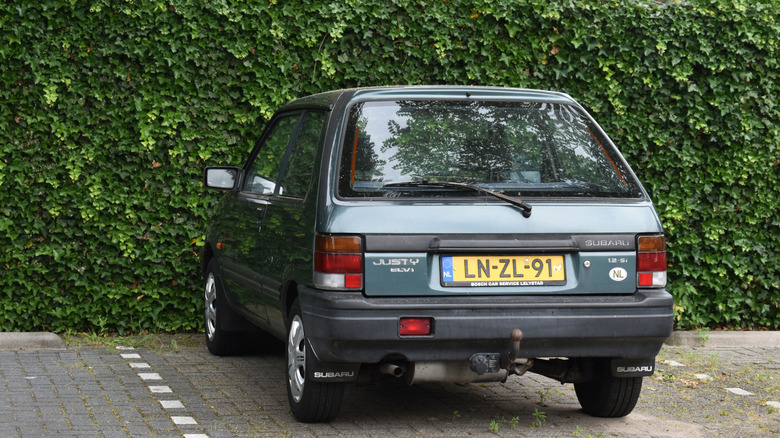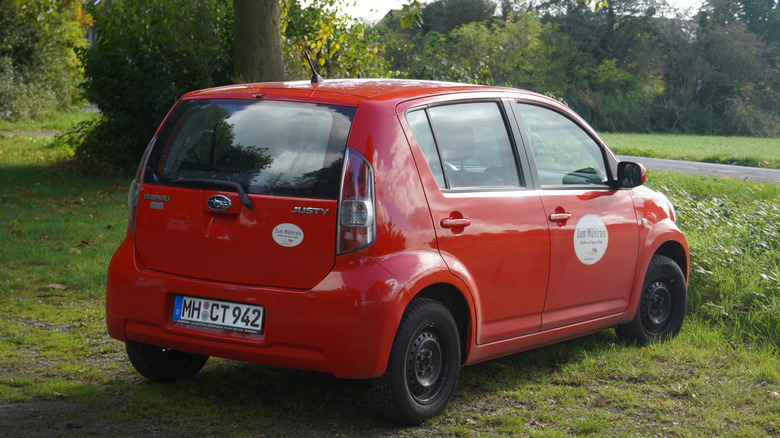Why So Many Different Cars Have The Subaru Justy Name
The Subaru Justy has established a unique presence in automotive history after its badge graced a variety of vehicles through the years. Since originally debuting as a small, economical three-door hatchback, the Justy name has been associated with different designs and vehicles. This is due to Subaru executing a unique strategy to adapt its models to different global markets by collaborating with other manufacturers. This practice, known as badge engineering or rebadging, allowed Subaru to expand its reach by offering vehicles developed by its partners under the Justy nameplate.
Through partnerships with brands like Suzuki and Daihatsu, Subaru ensured the Justy could cater to varying regional demands while maintaining its reputation for affordability, reliability, and practicality. Hence, despite decades of transformation, the Justy was able to remain relevant. In fact, Subaru was able to establish brand recognition even as the underlying cars changed. However, the fifth-generation Justy, introduced in 2016, appears to be the last in the series of Subaru's badge engineering efforts, at least for now. Yet, given Justy's history of reappearing in different forms and markets, it wouldn't be surprising to see the name resurface in the future.
The original Subaru Justy: Compact and innovative
The original Subaru Justy debuted in 1984 for the Japanese market as a subcompact hatchback designed to fill the growing demand for fuel-efficient cars while also avoiding road taxes. It was initially powered by a small 1.2-liter, three-cylinder engine. However, it eventually became available with four-wheel drive, which set it apart from many competitors in its class.
The first-generation Justy was entirely Subaru-designed and manufactured, embodying the brand's commitment to practical yet innovative engineering. It underwent modifications in the years it was in production under Subaru, including the addition of the world's first electro-continuously variable transmission (ECVT) in 1987, the four-wheel drive option in 1988, and the five-door body style with an optional CVT in 1989. The version that arrived in the U.S. in 1987 came with one of the most reliable Subaru engines ever made, the EF12 Subaru engine, and a manual transmission. Then, as other options became available, they found their way to the U.S. market as well.
When the first-generation Justy ended production in 1994, Subaru no longer developed an in-house follow-up. Instead, the Japanese automaker came up with a strategy to keep the nameplate alive through overseas collaborations with other manufacturers.
Subaru's global partnerships led to rebadges
Subaru's strategy to rebadge the Justy name allowed the carmaker to enter new markets or offer products where it lacked in-house designs. For instance, the second-generation Justy, introduced in 1994, was based on the Suzuki Swift, which was sold in European countries. Years later, Subaru's partnership with Suzuki led to another rebadging when the AWD Suzuki Ignis carried the Justy nameplate for the European market in 2004. This G3X Justy-branded model became the third generation in the unofficial Justy line — in some countries, the model name was the Subaru Trendy.
The Justy nameplate continued to evolve in the years that followed, especially after Subaru entered into another partnership with Daihatsu, a Toyota subsidiary, in 2007 to rebadge the Daihatsu Sirion as the Subaru Justy. This generation of the Justy reflected Toyota-Daihatsu engineering. Hence, it looked way different from the earlier generations. In late 2016, the Toyota Roomy/Tank/Daihatsu Thor was rebadged to become the new-generation Justy, and this further strayed from the conventional Justy form since it was a compact minivan.
Through partnerships with other brands, the Justy became a chameleon in the automotive world. Depending on the market, a Subaru Justy looked completely different from another Justy sold elsewhere. This approach allowed Subaru to cater to regional preferences while minimizing development costs for new models. This also allowed it to preserve the Subaru nameplate for more than three decades.


